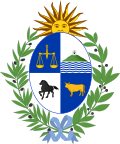This article possibly contains original research. (April 2009) |
| Uruguayan Portuguese | |
|---|---|
| português uruguaio | |
| Native to | North-eastern Uruguay, near Brazilian border |
Native speakers | 30,000 (2016)[1] |
| Language codes | |
| ISO 639-3 | – |
| Glottolog | None |
| Linguasphere | 51-AAA-am[2] |
| IETF | pt-UY |
| This article is part of a series on the |
| Culture of Uruguay |
|---|
 |
|
Uruguay Portal |
Uruguayan Portuguese (português uruguaio, [poɾtuˈɣes uɾuˈɣwajo]), also known as fronteiriço[2] ([fɾõteˈɾiso]) and riverense, and referred to by its speakers as portunhol[3] (local pronunciation: [poɾtuˈɲɔl]), is a variety of Portuguese in South America with heavy influence from Rioplatense Spanish. It is spoken in north-eastern Uruguay, near the Brazilian border, mainly in the region of the twin cities of Rivera (Uruguay) and Santana do Livramento (Brazil). This section of the frontier is called "Peace Border" (Portuguese: Fronteira da Paz; Spanish: Frontera de la Paz), because there is no legal obstacle to crossing the border between the two countries.
The varieties of Uruguayan Portuguese share many similarities with the countryside dialects of the southern Brazilian state of Rio Grande do Sul, such as the denasalization of final unstressed nasal vowels, replacement of lateral palatal /ʎ/ with semivowel /j/, no raising of final unstressed /e/, alveolar trill /r/ instead of the guttural R, and lateral realization of coda /l/ instead of L-vocalization. The first two features are rare among accents of Portuguese, whereas L-vocalization is the norm in Brazil but not in other countries.[4]
Recent changes in Uruguayan Portuguese include the urbanization of this variety, acquiring characteristics from urban Brazilian Portuguese such as a distinction between /ʎ/ and /j/, affrication of /t/ and /d/ before /i/ and /ĩ/, and other features of Brazilian broadcast media.[5] Uruguayan Portuguese now exists on a spectrum, ranging from working-class rural varieties to middle class urban ones. Middle class Uruguayan Portuguese has undergone heavy convergence to the monolingual Brazilian Portuguese standard, and is perceived by middle class Brazilians to be similar to their own speech.[6]
- ^ Portugues at Ethnologue (25th ed., 2022)

- ^ a b "Fronteiriço - hortensj-garden.org". www.hortensj-garden.org.
- ^ Lipski 2006, p. 7.
- ^ Carvalho 2004, p. 131.
- ^ Carvalho 2004, p. 144.
- ^ Carvalho 2014.